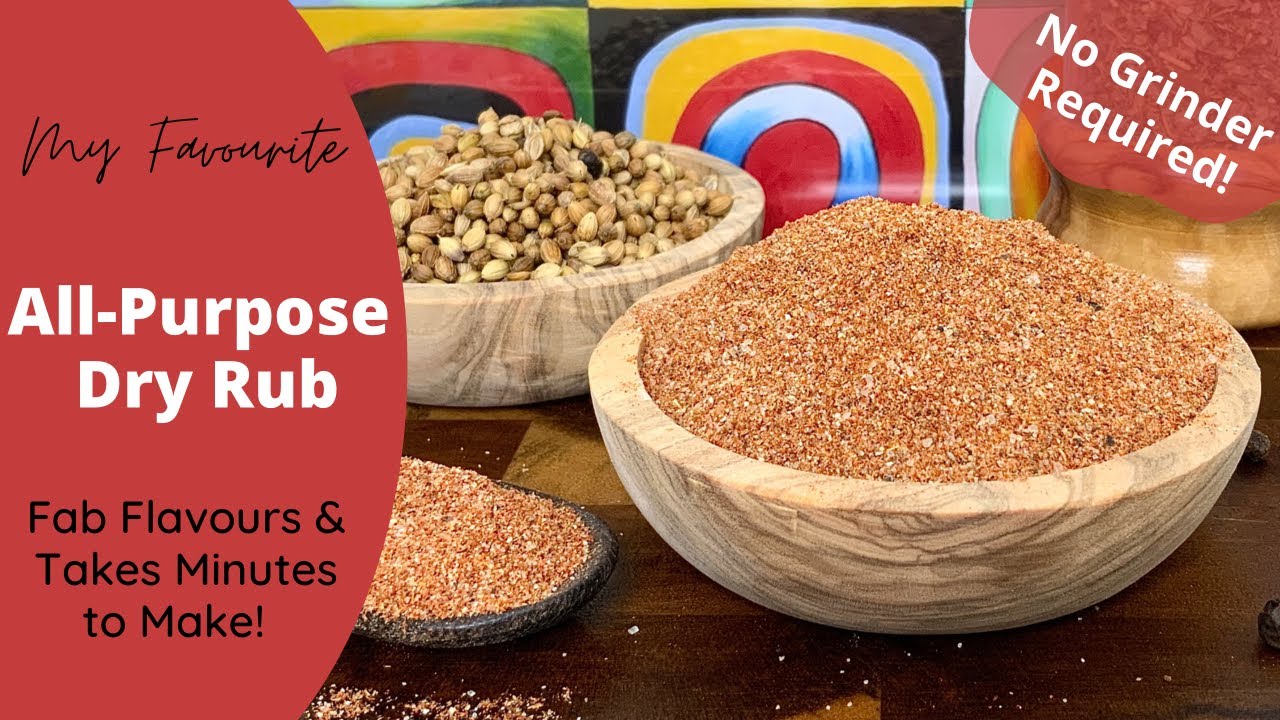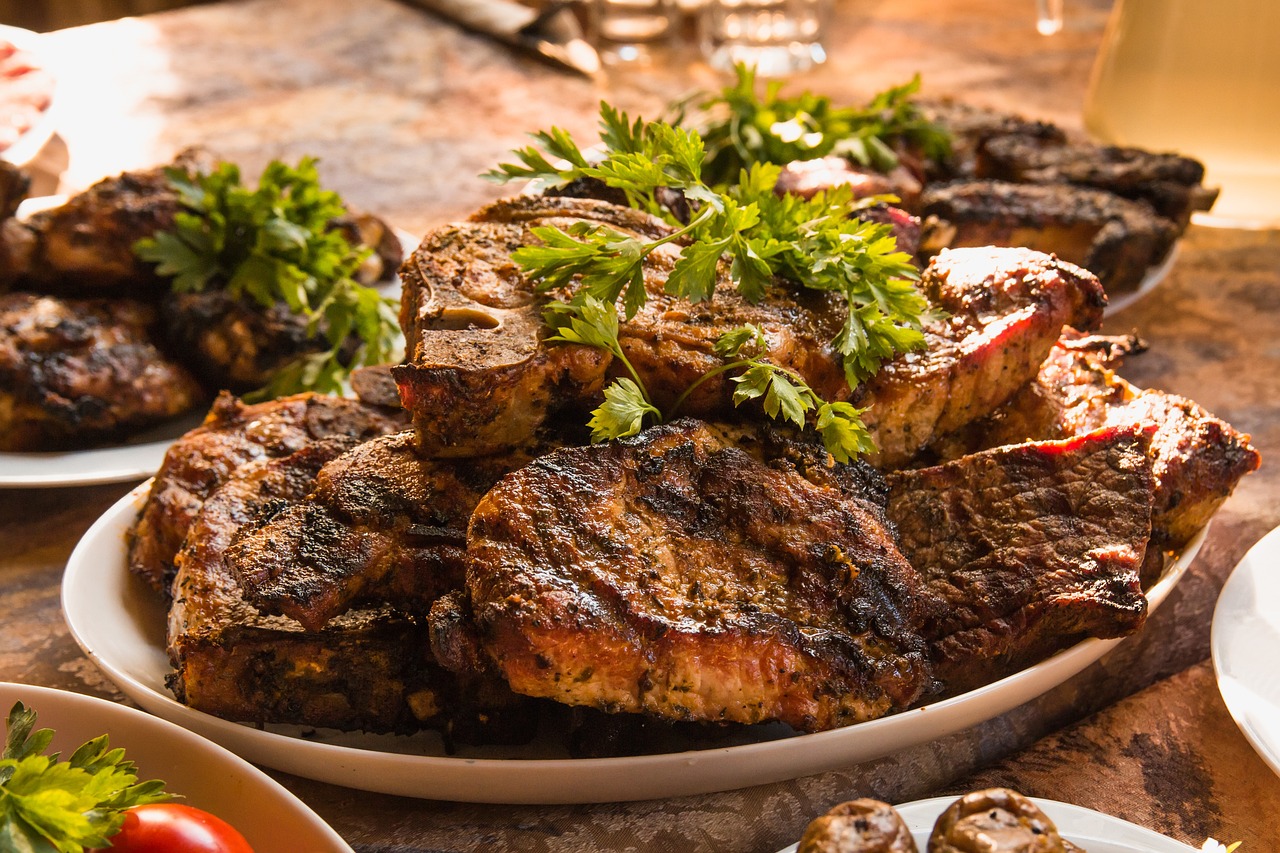![How To Create Spice Rubs For Meats [Here’s What To Know]](https://www.hangrypants.com/wp-content/uploads/2024/12/0534c04145110861/how-to-create-spice-rubs-for-meats.jpeg)
A well-crafted spice rub transforms ordinary meat into a mouth-watering experience, enhancing flavor and texture. Spice rubs come in two main forms: dry rubs and wet rubs.
While dry rubs are a blend of dry spices and herbs massaged into the meat, wet rubs include a small amount of oil to form a paste, helping the rub adhere to the surface of the meat. Both types infuse flavors deeply, bringing out the best in every cut of meat.
Creating your spice rub allows you to explore flavors, discover unique combinations, and add a personal touch to your cooking. With a few foundational ingredients and techniques, you can craft a signature rub that turns each meal into a delicious experience.
What Is A Spice Rub?
A spice rub is a mixture of herbs, spices, and sometimes sugar, applied to the meat’s surface before cooking. This blend creates a flavorful outer crust, adding a concentrated burst of flavor with every bite. While sauces can sometimes mask the natural taste of meat, spice rubs provide a balanced layer of seasoning without overpowering it.
Dry Rubs are made entirely of dry ingredients and are ideal for grilling, roasting, and smoking. They allow for a crispy texture and concentrated flavor.
Wet Rubs include a small amount of oil, helping them cling to the meat’s surface and lock in moisture, which can be especially beneficial for leaner cuts. Both styles have their advantages, allowing for versatility depending on the dish and cooking method.
Essential Ingredients For A Great Spice Rub
A balanced spice rub includes a few essential components, each adding its own role to the final flavor profile. These are the core categories of ingredients:
Salt And Sugar
Salt and sugar create the foundation of most spice rubs. Salt enhances flavor, while sugar, especially brown sugar, caramelizes beautifully, forming a flavorful crust. The ratio between these two ingredients will vary depending on the meat and cooking method.
For beef or chicken, consider using kosher salt for its coarse texture, which enhances the flavor without oversalting. For pork, brown sugar pairs particularly well, balancing salt with a mild sweetness that complements the natural taste of the meat.
Read Also: How To Make Sugar-Free Jams
Peppers For Heat
Peppers bring a layer of heat to a spice rub, from the warmth of black pepper to the fiery kick of cayenne. Black pepper has a bold, earthy flavor, while white pepper offers a gentler heat, often used for lighter meats. For a more intense heat, try adding cayenne or chile powder, which bring varying levels of spice and depth.
Transition Spices
Transition spices balance the sweet and spicy elements, adding complexity without overpowering. Paprika is commonly used for its mild, smoky flavor, while cumin provides an earthy, aromatic quality. Chili powder is another versatile addition, blending spices like cumin, paprika, and garlic into a balanced, middle-ground flavor that works well in many rubs.
Flavor Enhancers
This category allows for creativity, letting you tailor the rub to your preferences. Garlic powder and onion powder add a savory depth, while ginger brings a zesty, bright note that complements poultry and seafood. Herbs like oregano and thyme provide a refreshing balanceto heavier spices, and rosemary lends a woodsy touch that works beautifully with grilled meats.
Specialty Ingredients
Specialty ingredients add a unique flair, transforming a standard rub into a signature blend. Try coriander for a lemony, earthy undertone, or mustard powder for a sharp, aromatic bite. These spices are ideal in small amounts, creating a distinctive rub that brings a new dimension to your dish.

How to Make an All Purpose Dry Rub in Minutes | Super Easy & No Grinder Needed
Understanding Meat Types And Choosing The Right Rub
Each type of meat has unique characteristics that influence which rub ingredients work best. Here are some general guidelines for crafting rubs that complement different types of meat:
Beef
Beef has a bold, rich flavor that pairs well with equally strong seasonings. Start with black pepper, kosher salt, and smoked paprika as a base, and add garlic powder and a pinch of cayenne for a touch of heat. For larger cuts, such as brisket or ribs, consider a longer marination to allow flavors to penetrate deeply.
Chicken
Chicken is mild, making it versatile for a range of spices. A combination of paprika, garlic powder, onion powder, and herbs like rosemary or thyme creates a balanced, flavorful crust. Adding a bit of brown sugar helps achieve a caramelized skin when grilling or roasting.
Pork
Pork’s natural sweetness shines with rubs that include brown sugar, smoked paprika, and cinnamon. Spices like cloves or ginger complement pork’s flavor profile, creating a rub that’s ideal for ribs, chops, or pork shoulder.
Fish And Seafood
Fish and seafood benefit from light, fresh flavors that don’t mask their delicate taste. Try a rub with lemon zest, dill, and coriander, which brings a subtle depth. Rosemary and thyme are also great additions, providing a fragrant accent that works well with grilled or roasted fish.
How To Make Your Own Spice Rub
1. Choose Your Base Flavor Profile
Decide whether you want a sweet, smoky, spicy, or savory profile. Start with an equal mix of salt and sugar for a balanced foundation, adjusting according to the meat and desired flavor.
2. Select Spices And Herbs
Pick spices that match your meat’s natural flavors. For instance, paprika, garlic powder, and cumin make an excellent base for beef, while rosemary, thyme, and lemon zest enhance the freshness of fish.
3. Measure And Mix
Use a consistent ratio to balance flavors, beginning with approximately four tablespoons of salt or sugar. Mix thoroughly in a small bowl until evenly distributed.
4. Test And Adjust
Taste a pinch of the rub before applying it to ensure the balance of flavors is to your liking. Adjust as needed to achieve your ideal profile.
5. Storing Your Rub
Store your rub in an airtight container, away from heat and light, for up to six months. Label each batch with the date for freshness.
Applying Spice Rubs: Techniques For Maximum Flavor
Preparation Tips
For a dry rub, ensure the meat’s surface is dry to help the rub adhere. Massaging the rub into the meat thoroughly enhances the flavor absorption and creates an even coating, a technique that works beautifully with lean meats like roast venison.
Dry Rub Techniques
Apply a generous amount of rub and work it into the meat’s surface with your hands. For maximum flavor, let the rub sit on the meat for a few hours or overnight in the refrigerator, allowing the spices to penetrate the surface.
Wet Rub Techniques
Wet rubs are ideal for leaner cuts that benefit from extra moisture. Mix a small amount of oil into your spice blend, forming a paste, and apply evenly. The oil helps the rub cling to the meat, retaining moisture during cooking.
Marination Tips
Letting the rub sit on the meat for several hours, or ideally overnight, enhances the flavors. For smaller cuts, 1-3 hours is sufficient, while larger cuts like brisket or pork shoulder benefit from up to 24 hours.
See Also: How To Balance Spices In Cooking
Common Spice Rub Mistakes And How To Avoid Them
Over-Salting Or Over-Spicing
Too much salt or spice can mask other flavors. Start with a balanced ratio and taste-test as you go to prevent overwhelmingthe meat.
Using Stale Spices
Old spices lose their potency. To ensure a flavorful rub, use fresh spices and replace any that have been open for more than six months.
Applying Too Much Rub
A thick coating can prevent the meat from cooking evenly. Aim for a moderate layer, ensuring the meat’s natural flavor shines through.
Spice Rub Recipes To Try
Classic BBQ Dry Rub
This all-purpose rub is perfect for beef, pork, and chicken:
- 1/3 cup smoked paprika
- 1/3 cup kosher salt
- 2 tablespoons black pepper
- 1 tablespoon brown sugar
- 2 tablespoons garlic powder
- 1 tablespoon onion powder
Cajun Spice Rub
A bold rub with a kick, ideal for chicken and seafood:
- 1 tbsp paprika
- 1 tsp cayenne pepper
- 1 tsp garlic powder
- 1 tsp dried thyme
Citrus Herb Rub
Light and refreshing, great for fish and chicken:
- 1 tbsp lemon zest
- 1 tbsp dried parsley
- 1 tsp garlic powder
- 1 tsp black pepper
FAQs
What’s The Best Way To Store Homemade Spice Rubs?
Store them in airtight containers in a cool, dark place to keep them fresh for up to six months.
Can Spice Rubs Be Used On Vegetables?
Absolutely! Spice rubs add depth to roasted vegetables and other plant-based dishes.
How Do I Know If My Rub Is Fresh?
Fresh rubs have a strong aroma and vibrant color. If these qualities fade, it’s time for a new batch.
How Can I Adjust A Rub To Make It Spicier?
Increase cayenne or chili powder to intensify the heat. For a milder rub, reduce these ingredients.
Conclusion
A well-made spice rub can bring out the best in any meat, whether it’s grilled, roasted, or smoked. Crafting your rubs allows you to create flavors that reflect your style and preferences.
The beauty of homemade rubs is the flexibility to adjust spices, herbs, and heat levels, creating blends that suit not only the meat but also the occasion and your guests' preferences. There’s a satisfaction that comes with perfecting a rub recipe, knowing that each ingredient has been chosen and balanced with intention.
You Might Like: What Are The Best Ways To Reduce Bitter Flavors In Food?
